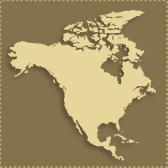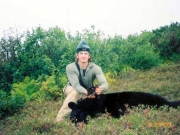Adventure Planner
Western Alaska – Bear
Western Alaska offers excellent brown bear/grizzly bear hunting. Much of it has been unhunted or lightly hunted until recent years. The seasons are long, with a variety of unique hunting conditions available in both the spring and the fall. Bears can be hunted in the spring in April and May with hunts in April being conducted by Supercub aircraft, snowmobiles, snowshoes, and spike camps. They can also be hunted in the fall when they combine bear hunting with giant moose, barren ground caribou, and black bear. Our hunters enjoy 80 – 90% success on brown/grizzly bear in this area when hunts are booked for 14 days or longer. Success is also high on moose, caribou, etc. This actually is one of our most popular hunting trips to Alaska but, as mentioned earlier, the key is in having enough time to hunt for all species.
Spring
Hunting season begins as early as mid March and runs until mid to late May. Early in the season, snow is deep, standing five to ten feet on level ground. The days are long, with 16 to 20 hours of daylight, so in reality, more daylight hours than are physically possible to hunt.
At this time of the year, weather is normally pretty good, with brilliant, sunny days and temperatures running in the 20’s to 40’s in the daytime. It is clear and cold at night, often down to zero degrees. At this time of year, the big bears are emerging from their winter sleep. It is normal for the largest male bears to emerge from their dens a month or more in advance of sows and cubs. Generally their fur is thick and luxurious. Hunting bears in the spring is almost always more productive than fall hunting.
March & April
Large brown bears and grizzly bears are impressive predators, often killing two or more moose a week, as they wait for the snow to melt and vegetation to grow. These large boars will linger on a kill site for weeks on end. They are often seen snoozing just outside their den. Tracks, dens, and kill sites are easily spotted. Airplanes are used to transport you into the hunting areas. Snowshoes and even snowmobiles are used to transport you to the heart of good bear country.
This is perhaps the most productive time in Alaska to harvest a truly large bear with the greatest frequency. Over 60% of the bears harvested by our hunters in recent years have been nine-foot class bears, unmatched anywhere else. Don’t expect to see a lot of bears at this time of year, but what you see will be as big as they come.
Accommodations are comfortable, usually comfortable cabins or even extremely elaborate lodges. Occasionally a spike camp will be used to put you in close proximity of bigger bears for a night or two.
May
In many areas of western Alaska, good hunts are conducted during May. The normal method is to fly out into remote hunting areas where bears are often found and land on ridgetops where snows are receding, allowing bare ground landings and travel. Once on the ground, a spike camp is set up and hunters travel along these ridgetops, glassing vast areas to locate bears. Once they are found, hunters bail off these ridges and go after the bears on foot. Sometimes much snow can be encountered on the valley bottom so snowshoes may be necessary. Many of these hunts are based out of interior areas where spring comes a bit later. This is the best time period to hunt them.
Costs
10 to 14 days $14,500 to $16,550
Dates are available mid-March through Mid-May. Black bear are usually available at little to no additional cost.
Fall
Mixed bag hunts are some of the most productive that we arrange in North America. Good populations of brown bear/grizzly, moose, caribou, and black bear will normally keep you and your guide busy. The season opener for mixed bag is normally September 1. Different types of combo hunts run through the middle of October, although moose season closes in Alaska in most areas by September 25. However, there are exceptions.
Alaska’s mightiest rivers, the Yukon and the Kuskokuim, flow through this region. There are many other rivers and tributaries that flow into these large rivers. This region is well known for its large moose, running in the 60 to 70-inch class. The great Mulchatna caribou herd also roams this area and hunters can take two per season. Good black bear populations are found in this region as well, and are attracted to the same sources of food as brown/grizzly bear. Salmon fill many of the rivers and streams and bears concentrate along these river areas. Wolf and wolverine are taken with some regularity, and certainly don’t forget to bring your fishing pole. Five different species of salmon and a variety of trout are found in these rivers.
Costs & Dates
Brown bear/grizzly bear, caribou, moose, and black bear, privately guided, usually 90 to 100% kill on primary species. Usually hunters bag two to three species during a ten to 14-day hunt. Seasons run September 1 to 25 for all species and September 25 onward for a brown bear/caribou hunt. Ten days, $16,500, 14 days up to $19,000.
Spring – Interior
Spring grizzly hunts in Alaska, British Columbia, and the Yukon Territory usually take place during April, May, and early June. Typically the hunts are divided into two types of programs. In April and early May, there is a go



